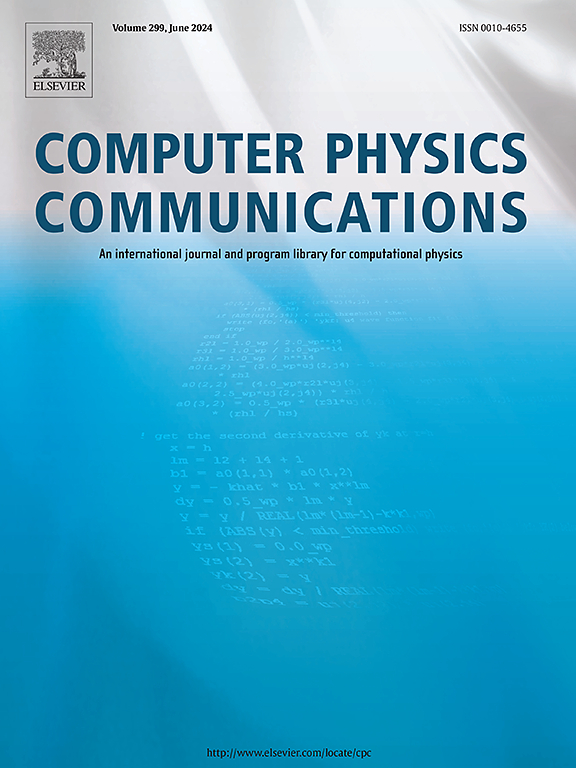A local and explicit forcing correction for Lagrangian immersed boundary methods
IF 3.4
2区 物理与天体物理
Q1 COMPUTER SCIENCE, INTERDISCIPLINARY APPLICATIONS
引用次数: 0
Abstract
Lagrangian immersed boundary methods (IBM) are widely used to study flows with complex and moving boundaries, such as biological flows. However, it has been noted that in some cases the resulting no-slip condition at the wet tissues is inaccurate. In this work, we propose an improved technique to evaluate the IBM forces with the aim of reducing slip and transpiration velocities at the immersed wet surfaces. In the framework of Moving Least Squares transfer function (MLS-IBM), we first formulate the problem of determining the IB forces in an implicit manner. Although this approach enforces the no-slip condition to machine precision, we demonstrate that this method is unaffordable for moderate/high Reynolds number flows. Nevertheless, insight of the implicit formulation reveals that it is possible to derive analytically a local correction to the IB forcing via an approximate factorisation of the system matrix of the implicit IBM. The resulting correction is fully explicit and it can be easily implemented in existing IB codes and extended to other Lagrangian IBMs. Our approach is then tested and compared against standard IBM-MLS (also in its iterative version) in a series of benchmark flows, including fixed and moving rigid bodies, and finally in the biological flow within a rigid aorta. Importantly, the proposed correction is seen to greatly improve the consistency and convergence properties of the IBM-MLS.
拉格朗日浸入边界法的局部和显式强迫修正
拉格朗日浸入边界法(IBM)被广泛用于研究具有复杂和移动边界的流动,如生物流动。然而,需要注意的是,在某些情况下,湿组织处的无滑移情况是不准确的。在这项工作中,我们提出了一种改进的技术来评估IBM力,目的是减少浸入湿表面的滑移和蒸腾速度。在移动最小二乘传递函数(MLS-IBM)的框架中,我们首先以隐式方式制定了确定IB力的问题。虽然这种方法强制无滑移条件的机器精度,我们证明,这种方法是不可承受的中/高雷诺数流动。然而,隐式公式的洞察力表明,有可能通过隐式IBM系统矩阵的近似因式分解,解析地推导出IB强迫的局部校正。所得到的校正是完全显式的,它可以很容易地在现有的IB代码中实现,并扩展到其他拉格朗日ibm。然后,我们的方法在一系列基准流中与标准IBM-MLS(也在其迭代版本中)进行测试和比较,包括固定和移动刚体,最后在刚性主动脉内的生物流中。重要的是,所提出的修正被认为大大提高了IBM-MLS的一致性和收敛性。
本文章由计算机程序翻译,如有差异,请以英文原文为准。
求助全文
约1分钟内获得全文
求助全文
来源期刊

Computer Physics Communications
物理-计算机:跨学科应用
CiteScore
12.10
自引率
3.20%
发文量
287
审稿时长
5.3 months
期刊介绍:
The focus of CPC is on contemporary computational methods and techniques and their implementation, the effectiveness of which will normally be evidenced by the author(s) within the context of a substantive problem in physics. Within this setting CPC publishes two types of paper.
Computer Programs in Physics (CPiP)
These papers describe significant computer programs to be archived in the CPC Program Library which is held in the Mendeley Data repository. The submitted software must be covered by an approved open source licence. Papers and associated computer programs that address a problem of contemporary interest in physics that cannot be solved by current software are particularly encouraged.
Computational Physics Papers (CP)
These are research papers in, but are not limited to, the following themes across computational physics and related disciplines.
mathematical and numerical methods and algorithms;
computational models including those associated with the design, control and analysis of experiments; and
algebraic computation.
Each will normally include software implementation and performance details. The software implementation should, ideally, be available via GitHub, Zenodo or an institutional repository.In addition, research papers on the impact of advanced computer architecture and special purpose computers on computing in the physical sciences and software topics related to, and of importance in, the physical sciences may be considered.
 求助内容:
求助内容: 应助结果提醒方式:
应助结果提醒方式:


